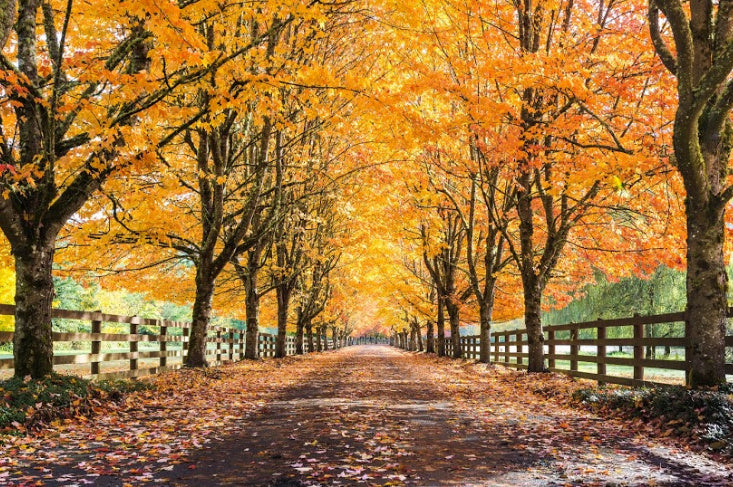
Fall Has Arrived! Interesting Facts About Trees During the Fall
In many parts of the country, Fall is a time when leaves turn brilliant colors and make for a spectacular sight to see! Surprisingly, most of these amazing colors have been in the leaves all Summer long, however, we don’t see them because they have been masked by the dominant green color from chlorophyll, a photosynthetic pigment that turns sunlight into food. As temperatures become cooler in the Fall, the leaves are not able to produce as much food for the tree and the tree begins to rely on stored sugars to last through Fall and Winter. As this happens, the chlorophyll breaks down and the green leaf color goes away revealing new, amazing colors!
Why are there different colors of leaves?
In the Spring and Summer months, most trees display their beautiful green leaves. This green color comes from chlorophyll, a pigment found in plants that helps convert sunlight into food energy. When temperatures become cooler in the Fall and chlorophyll breaks down, other colors in the leaves appear.

This colors visible in the Fall include the following:
Red: The red color in leaves is due to anthocyanin. Unlike other leaf colors such as orange and yellow that are always present in the leaves (but hidden by the dominant green color most of the year), anthocyanin is produced by the tree when the chlorophyll breaks down and the green color goes away. Brilliant red colored leaves can be found in the Fall in Red Maples and Scarlet Oaks, among other special trees.
Orange: The orange color seen in leaves is due to carotene. This spectacular color is one of many things that makes the Sugar Maple tree so special (carotene is also the same chemical responsible for giving carrots their unique orange color). The dominant brilliant orange displayed by the Sugar Maple tree fills the hills of the Northeast in the Fall and is a beautiful sight to see!
Yellow: The yellow color seen in leaves of certain trees such as ash, beech, birch, aspen, and some oaks comes from xanthophyll, a yellow pigment that occurs widely in nature. This brilliant yellow color goes on full display throughout the Rocky Mountains in late September and into early October and can also be found in other places throughout the U.S. In addition to being present in trees, xanthophyll is also found in squash and corn!
Why do trees drop their leaves?
Deciduous trees, such as ash, beech, elm, aspen, cherry, oak, maple, willow, poplar, and birch trees, shed their leaves each Fall to prepare for the Winter. Evergreen trees are different and keep their green foliage year-round. Evergreens can do this because most live in warm or wet areas, or they have narrow, weather resistant needles rather than large leaves that are present on deciduous trees. These large leaves require a significant amount of energy to maintain.
As the weather changes and there is less daylight, hormones in deciduous trees let it know it is time to start the process to shed its leaves for the Winter. At the beginning of this process, the tree will absorb some of the nutrients from the leaves and store them so they can be used later. Then, tree hormones trigger a process whereby the tree uses its cells to form a bumpy line at the place where the leaf stem meets the branch. The leaves are then actively “pushed” or “cut” off the branch. After the leaves are removed, most trees will grow a protective cell layer over the exposed area.
Below are three main reasons why trees drop their leaves in the Fall:
- To Survive Upcoming Harsh Weather Conditions. The main reason why trees shed their leaves is part of a strategy to survive upcoming harsh weather conditions. Most deciduous trees display broad leaves that can be damaged with cold or dry weather. Alternatively, evergreen trees keep their leaves year-round with their hardy, weather-resistant needles as leaves.
- Conserve Water and Energy. Dropping its leaves in the Fall helps a tree conserve water and energy. This helps the tree focus its energy on root growth in the Fall and helps it survive harsh Winter weather.
- Helps with Pollination. After trees shed their leave and when springtime comes around, it is much easier for pollen to be carried by the wind and reach more trees. This helps the pollination process!
Even though deciduous trees become dormant and are without leaves, they are still active - efficiently using their energy and resources to expand their root systems. A strong root system will better position the tree to grow in the Spring. Also, dropping its leaves creates a layer of mulch that covers the surface of the growing environment, which insulates the soil and keeps it moist.
Why is Fall a great time to plant trees?
Many arborists and other tree experts consider Fall to be one of the best times of the year to plant trees. But why? The reason is simple - in the Fall, trees have less to do and can spend their energy on becoming established. Deciduous trees, such as maples, oaks, cherry, poplar, birch, elms, and willows, shed their leaves in the Fall and use their energy during this time on growing and expanding their root systems. With a larger and more expansive root system, the tree will have greater access to water and nutrients when it is ready to add leaves and mass above ground in the growing season. Moreover, in the Fall and Winter, a newly planted tree can devote its energy to its roots, whereas if it was planted in the Spring or Summer, the tree would need to divide its energy and resources to also support its leaves and branches, which can add stress.
In addition, the cooler temperatures present in the Fall promote and encourage underground root growth, compounding the effect. And, as the weather cools, trees no longer have the stress that can occur with extreme heat and dry conditions and the Fall window presents a great planting opportunity before potentially harsh Winter conditions set in.
In summary, Fall is a great time of year to plant a tree! If you had a loved one (or pet) pass during the year, Fall is also a great time of year to plant a living tree memorial with The Living Urn’s bio urn and planting system. This patented system allows you to grow a beautiful and enduring memory tree from the special tree urn containing cremated ashes. With The Living Urn, families can honor a loved one and give back with a special living memorial.

